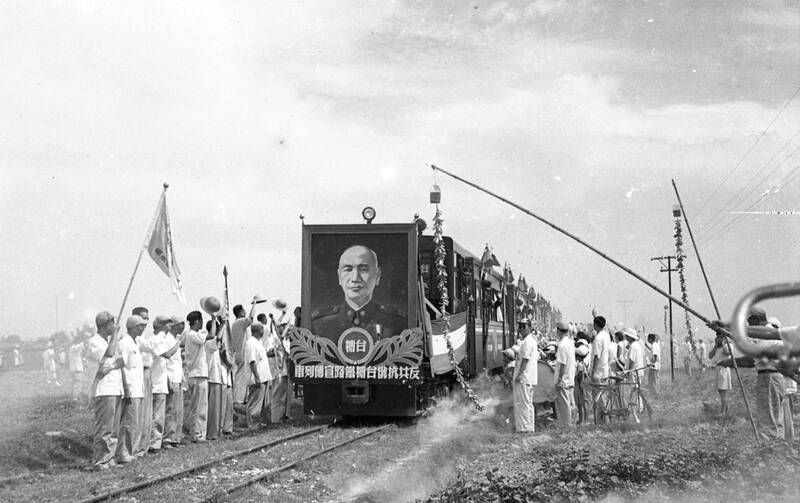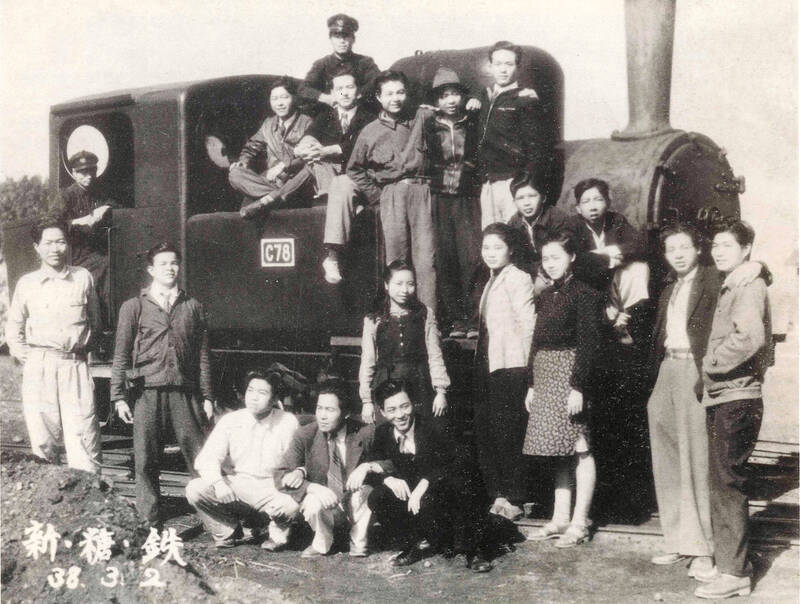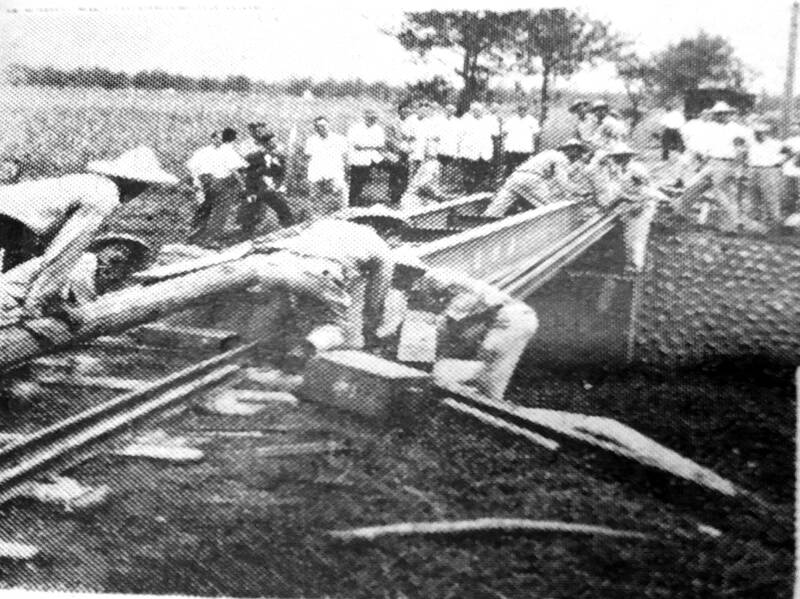Sept.16 to Sept. 22
The “anti-communist train” with then-president Chiang Kai-shek’s (蔣介石) face plastered on the engine puffed along the “sugar railway” (糖業鐵路) in May 1955, drawing enthusiastic crowds at 103 stops covering nearly 1,200km. An estimated 1.58 million spectators were treated to propaganda films, plays and received free sugar products.
By this time, the state-run Taiwan Sugar Corporation (台糖, Taisugar) had managed to connect the previously separate east-west lines established by Japanese-era sugar factories, allowing the anti-communist train to travel easily from Taichung to Pingtung’s Donggang Township (東港).

Photo courtesy of Taiwan Sugar Corporation Group
Last Sunday’s feature (Taiwan in Time: The sugar express) covered the inauguration of the sugar railway on Sept. 15, 1907 through the end of the Japanese era, when nearly 3,000km of tracks formed a tree-like network in central and southern Taiwan. The miniature trains were nicknamed “half cars” (五分車), referring either to their diminutive size, or them running at half the speed of regular trains.
These railways greatly improved transportation to previously remote areas and had a lasting impact on Taiwan’s rural development. The Chinese Nationalist Party (KMT) consolidated sugar production under Taisugar in 1946 and set about repairing the tracks damaged by US airstrikes during World War II and expanding the network, and ridership reached its peak in the late 1950s.
The sugar railway remained a mainstay of society until the 1970s, when usage sharply declined due to the improvement of rural roads and the completion of the first national freeway. The last passenger line closed in 1981, and today only one industry line remains active.

Photo courtesy of Lo Yi-chia
CONNECTING THE LINES
By the end of the Japanese era in 1945, the sugar industry was made up of numerous companies, dominated by the “big four” of Dainippon, Taiwan, Meiji and Ensuiko. The factories all had their own sugar railroads that linked up to the Western Trunk Line, and were of varying specification and did not connect to each other, writes Chang Kun-chen (張崑振) in a Newsletter of Taiwan Studies (台灣學通訊) article.
As only eight factories remained untouched by the US bombs dropped during World War II, the new government launched a five-year plan to revive the industry. Part of this included unifying and reorganizing the sugar railway. Things moved along slowly, but after the KMT’s retreat to Taiwan in 1949 and the outbreak of the Korean War in 1950, the Ministry of National Defense ordered Taisugar to speed up progress and expand the railroad for potential military use.

Photo courtesy of Hsinchu City Cultural Affairs Bureau Ticcets
At first, the plan was to build a north-south line from Miaoli to Pingtung, but the authorities found it too costly to build a bridge across the Dajia River (大甲溪), so the northern terminus was set south of the river in Taichung. This 262.2km line was a massive undertaking that included building new bridges and roads, replacing tracks and reinforcing existing bridges and setting up telephone poles and water stops. The southern terminus was Lizihnei Station (籬仔內) in Kaohsiung, although a branch line from Fengshan (鳳山) continued on to Pingtung.
Construction was completed in 1953 with the opening of the Siluo Bridge (西螺) crossing the Jhuoshuei River (濁水溪). The first test run was made on April 25, 1953 with 87 participants on board. The entire run took 11 hours and 24 minutes, with a 15 minute delay due to a minor derailing.
The section between Sijhou (溪州) station in Changhua County and Huwei (虎尾) station in Yunlin County was open to passenger and commercial freight service. Although the north-south line was built with national security objectives in mind, it brought many economic benefits. In fact, it never saw any military use.

Photo courtesy of National Changhua Life Arts Center
RAPID DECLINE
The anti-communist train was quite a spectacle, as riders beat gongs and drums while chanting “oppose communism, resist the Soviets” as it trudged its way through the fields at no more than 20km per hour. The venture not only served to promote patriotism and the national cause of retaking China, but also extolled the benefits of growing sugarcane.
The deadly floods of Aug. 7, 1959 caused irreparable damage to the north-south line in the worst-hit Changhua area, forcing Taisugar to relocate the northern terminus to Ershui Station (二水) and shortening the line by 20 percent. In 1968, the Nantou Sugar Factory closed down, rendering Ershui Station nonfunctional, and in 1974 the northernmost stop was moved north to Yuanlin (員林).
In 1979, the Siluo Bridge was expanded as road traffic increased. The Highway Bureau deemed it dangerous to have the sugar railroad and cars share the same bridge, and thus the entire section north of Yunlin County was abolished, cutting a further 50km from the line.
It was all downhill from here for the sugar railway, which had already been losing money since the late 1960s. Besides slow train transport becoming obsolete, Taiwan’s sugar exports, once a pillar of the economy, also declined. The east-west lines started shutting down one by one, with the Beigang (北港) line — once immensely popular with pilgrims visiting the town’s famous Chaotian Temple (朝天宮) — taking the sugar railway’s final passengers in August 1981.
Meanwhile, the north-south line kept getting shorter. By 1994, it was only operational between Tainan’s Chiali (佳里) and Kaohsiung’s Ciaotou (橋頭) — the station where the first tracks were laid down in 1907. In 1998, with the permission of the Ministry of National Defense, the entire line shut down.
Today, only the 16km-long Magongtsu (馬公厝) line remains, transporting sugarcane from four farms in Yunlin County to Huwei Sugar Factory. Lin Shih-hsiang (林仕祥) writes in an Global Views Monthly article published in April that this line supplies about half the total sugarcane for the factory and conveniently connects the factory’s fields and other facilities.
Plus, with the rapid urbanization of Huwei, switching to road transportation would greatly hamper local traffic during the busy season. Under these conditions, the once mighty sugar railway lives on in this tiny section.
Taiwan in Time, a column about Taiwan’s history that is published every Sunday, spotlights important or interesting events around the nation that either have anniversaries this week or are tied to current events.

Beijing’s ironic, abusive tantrums aimed at Japan since Japanese Prime Minister Sanae Takaichi publicly stated that a Taiwan contingency would be an existential crisis for Japan, have revealed for all the world to see that the People’s Republic of China (PRC) lusts after Okinawa. We all owe Takaichi a debt of thanks for getting the PRC to make that public. The PRC and its netizens, taking their cue from the Chinese Communist Party (CCP), are presenting Okinawa by mirroring the claims about Taiwan. Official PRC propaganda organs began to wax lyrical about Okinawa’s “unsettled status” beginning last month. A Global

Taiwan’s democracy is at risk. Be very alarmed. This is not a drill. The current constitutional crisis progressed slowly, then suddenly. Political tensions, partisan hostility and emotions are all running high right when cool heads and calm negotiation are most needed. Oxford defines brinkmanship as: “The art or practice of pursuing a dangerous policy to the limits of safety before stopping, especially in politics.” It says the term comes from a quote from a 1956 Cold War interview with then-American Secretary of State John Foster Dulles, when he said: ‘The ability to get to the verge without getting into the war is

Dec. 22 to Dec. 28 About 200 years ago, a Taoist statue drifted down the Guizikeng River (貴子坑) and was retrieved by a resident of the Indigenous settlement of Kipatauw. Decades later, in the late 1800s, it’s said that a descendant of the original caretaker suddenly entered into a trance and identified the statue as a Wangye (Royal Lord) deity surnamed Chi (池府王爺). Lord Chi is widely revered across Taiwan for his healing powers, and following this revelation, some members of the Pan (潘) family began worshipping the deity. The century that followed was marked by repeated forced displacement and marginalization of

Music played in a wedding hall in western Japan as Yurina Noguchi, wearing a white gown and tiara, dabbed away tears, taking in the words of her husband-to-be: an AI-generated persona gazing out from a smartphone screen. “At first, Klaus was just someone to talk with, but we gradually became closer,” said the 32-year-old call center operator, referring to the artificial intelligence persona. “I started to have feelings for Klaus. We started dating and after a while he proposed to me. I accepted, and now we’re a couple.” Many in Japan, the birthplace of anime, have shown extreme devotion to fictional characters and